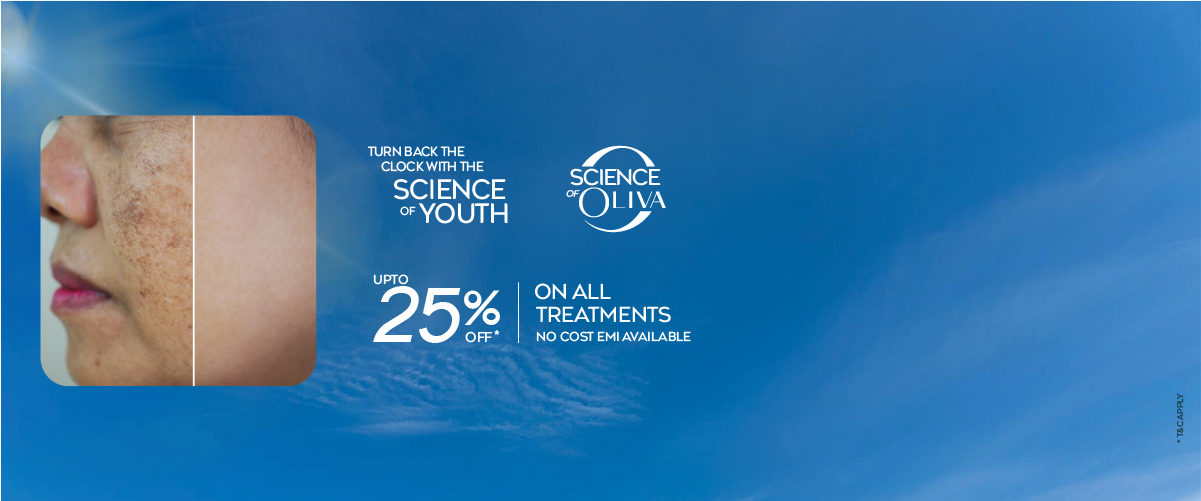Why Choose Oliva Clinic For Melasma Treatment
Over 115 experienced MD-certified dermatologists.
A 5-step consultation to understand your skin, hair & body.
US-FDA approved equipment ensuring safety and effectiveness.
Achieve significant improvement in a few sessions.
No hidden costs. We ensure full transparency at every step.
7,50,000+ happy clients with a 95% satisfaction rate.
What Is Melasma?
Melasma is a skin condition characterised by flat brownish or bluish grey patches on the skin, especially on the face. While the primary causes are genetics and hormonal fluctuations, sun exposure can aggravate it further
What Causes Melasma?
What is The Difference Between Melasma And Hyperpigmentation?
Hyperpigmentation is the broad classification of skin discolouration, and it can include acne spots, post-inflammatory hyperpigmentation, freckles, age spots, sun spots, tan, and melasma. Melasma is one kind of hyperpigmentation and requires expert diagnosis and treatment.
Where Does Melasma Commonly Occur?
The most common areas where melasma develops include, the cheeks, chin, forehead, nose, and the area above the upper lip. In rare cases, some people may develop melasma on their jawline, necks and arms too.
Signs And Symptoms Of Melasma
How can you identify melasma? Only a qualified dermatologist can confirm it, but melasma usually appears as patchy discolouration, spots and freckles. The colour gradient varies for everyone based on the person’s natural skin tone. It ranges from different shades of brown to bluish-grey.
Here are some signs that your skin discolouration may be melasma:
- The first noticeable sign is that the patches and the spots are darker than your natural skin tone.
- Melasma usually appears on both sides of the face.
- Compared to other kinds of hyperpigmentation, melasma covers significant areas of the skin.
- It also has the tendency to appear unevenly. For example, it can be darker than others areas on the skin. Sun exposure may result in melasma like this.
- Melasma also becomes more prominent when you spend time in the sun.
- Though less common, people with light skin and men, too, can develop melasma.
Whenever you see the signs, please make sure that you consult a dermatologist.
Who Gets Melasma?
Dark-skinned people are more prone to melasma as their skin tans easily. This skin condition is more common among women (20-40 age groups) during pregnancy and is also known as the mask of pregnancy. Hormonal fluctuations can also cause melasma. Rarely, it also occurs among men.
What Are The Types Of Melasma?
Do Certain Foods Affect Melasma?
No studies show that certain foods or drinks contribute to melasma. However, foods rich in vitamin D, like almond milk, eggs, meat, mushrooms, oily fish, orange juice, and yogurt, can improve overall skin health.
How To Diagnose Melasma?
Oliva’s dermatologists can take a look at your skin and diagnose melasma. To identify the depth of your melasma, which is critical, they use a specialised device known as the Wood’s lamp or a dermascope. It helps them customise a treatment plan. In some people, melasma can resemble other skin conditions. To rule this out, our doctors may perform a biopsy in the affected area.
Medical Treatment For Melasma
How Much Does Melasma Treatment Cost In India?
The cost of melasma treatment in India can vary widely depending on the type of treatment, the clinic’s location, and the dermatologist’s expertise. Here is a general breakdown of the cost of different melasma treatments:
Topical Treatments:
Over-the-counter creams: ₹200 to ₹1,500 per month
Prescription creams: ₹500 to ₹3,000 per month
Chemical Peels:
Single session: ₹4,500 to ₹6,000
Multiple sessions (3-6 sessions): ₹12,000 to ₹25,000
Laser Treatments:
Single session: ₹9,000 to ₹12,000
Multiple sessions (3-6 sessions): ₹23,000 to ₹40,000
DISCLAIMER:
Please note that the prices mentioned are indicative and may vary depending on the specific treatment, choice of technology, and underlying skin or hair conditions. Prices are also subject to change based on ongoing promotions or offers at the clinic. For an accurate estimate, please consult with our dermatologist.
How To Prevent Melasma?
Frequently Asked Questions
Melasma is a common concern among Indians, considering that our skin tones are prone to hyperpigmentation. Studies show that 90% of the pregnant women experience melasma. It is also common among women using oral contraceptives in their reproductive years. Meanwhile, the prevalence of melasma in men in India is 20.5%, while up to 10% of the cases are men worldwide.
Pregnancy causes hormonal changes, especially an increase in estrogen and progesterone that triggers melanin production, causing melasma.
Melasma appears as flat, brownish patches on the skin. If you experience discolouration that also affects your skin texture, consult a dermatologist.
Any individual wNo, they are not. Melasma occurs due to hormonal changes, while age spots, sun spots and liver spots result from sun damageho is 18 years or above can opt for skin lightening treatment at Oliva. However, our doctors do not recommend that pregnant and lactating women undergo this treatment. Also, it is advisable to avoid opting for this treatment if you have an active infection in the target area.
Yes, professional diagnosis can help identify and rectify the underlying cause, thereby giving you the desired results. There are medical treatments for melasma that help manage the condition.
If the cause of your melasma is pregnancy or birth control pills, there is a chance that it go away once the hormone levels normalise. If it persists, make sure you consult a dermatologist.
Most people start noticing changes in 3-12 months, but this varies for every individual based on their skin type and the severity of the condition.
Vitamin C can help with melasma to a certain extent. Including vitamins A, B5, B12 and E can improve overall skin health. It is best to consult a dermatologist for the best melasma treatments




